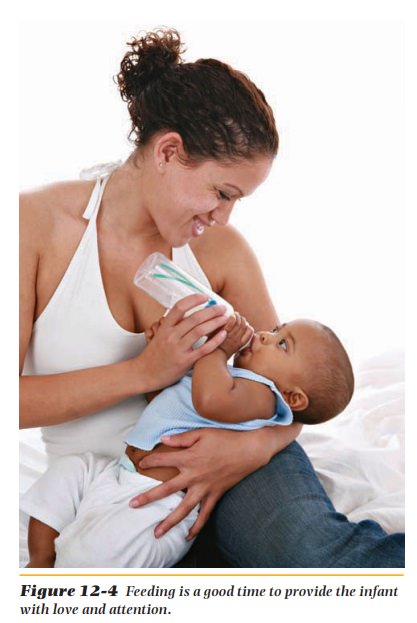Chapter: Nutrition and Diet Therapy: Diet During Infancy
Bottle Feeding

BOTTLE FEEDING
Many parents will
choose to bottle-feed their babies. Some women fear they will be unable to
produce enough breast milk. Some lack emotional support from their families,
and some simply find breastfeeding foreign to their culture. Others who are
employed or involved in many activities outside the home find bottle feeding
more convenient. Either way of feeding is acceptable provided the infant is
given love and attention during the feeding.
The infant should be
cuddled and held in a semi-upright position during the feeding (Figure 12-4).
It appears that babies fed this way are less inclined

It is believed that the upright position prevents fluid from pooling at the back of the throat and entering tubes from the middle ear. During and after the feeding, the infant should be burped to release gas in the stomach, just as the breast-fed infant should be burped (Figure 12-5). Burping helps prevent regurgitation.

If the baby is to be
bottle-fed, the pediatrician will provide information on commercial formulas
and feeding instructions. Formulas are usually based on cow’s milk because it
is abundant and easily modified to resemble human milk. It must be modified
because it has more protein and mineral salts and less milk sugar (lactose)
than human milk. Formulas, such as soy formula, are devel-oped so that they are
similar to human milk in nutrient and caloric values.
When an infant is
extremely sensitive or allergic to infant formulas, a synthetic formula may be
given. Synthetic milk is commonly made from soybeans. Formulas with predigested
proteins are used for infants unable to tolerate all other types of formulas.
Formulas can be
purchased in ready-to-feed, concentrated, or powdered forms. Sterile or boiled
tap water must be mixed with the concentrated and powdered forms. The most
convenient type is also the most expensive.
If the type purchased
requires the addition of water, it is essential that the amount of water added
be correctly measured. Too little water will create too heavy a protein and
mineral load for the infant’s kidneys. Too much water will dilute the nutrient
and calorie value so that the infant will not thrive, and also it could lead to
brain edema or seizures.
Infants under the age
of 1 year should not be given regular cow’s milk. Because its protein is more
difficult and slower to digest than that of human milk, it can cause
gastrointestinal blood loss. The kidneys are challenged by its high protein and
mineral content, and dehydration and even damage tothe central nervous system
can result. In addition, the fat is less bioavailable, meaning it is not
absorbed as efficiently as that in human milk.
Formula may be given
cold, at room temperature, or warmed, but it should be given at the same
temperature consistently. To warm the formula for feeding, place the bottle in
a saucepan of warm water or a bottle warmer. The bottles should be shaken
occasionally to warm the contents evenly. Warming the bottle in the microwave
is not advisable because milk can heat unevenly and burn the infant’s mouth.
The temperature of the milk can be tested by shaking a few drops on one’s
wrist. The milk should feel lukewarm.
Infants should not be
put to bed with a bottle. Saliva, which normally cleanses the teeth, diminishes
as the infant falls asleep. The milk then bathes the upper front teeth, causing
tooth decay. Also, the bottle can cause the upper jaw to protrude and the lower
to recede. The result is known as the baby bottle mouth or nursing bottle
syndrome. It is preferable to feed the infant the bedtime bottle, cleanse the
teeth and gums with some water from another bottle or cup, and then put the
infant to bed.
Related Topics